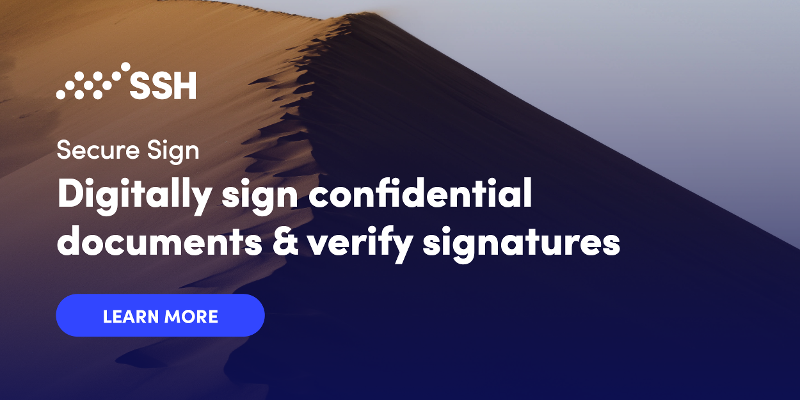How Digital Signatures Work
Contents
What Is a Digital Signature?
How Do Digital Signatures Work?
How Do I Create a Digital Signature?
Types of Digital Signatures
Benefits of Digital Signatures
The Difference Between Digital and Electronic Signatures
SSH Secure Sign

What Is a Digital Signature?
The purpose of digital signatures is to establish a means to identify the authenticity of a document. For centuries, businesses and governments alike have used manual signatures to serve this purpose, due to the uniquely expressive nature of each person’s signature. In the case of digital signatures, the authenticity of a document is arguably even more reliable than manual signatures, because the signer is identified with a unique private key.
Digital signatures aren’t signatures in the traditional sense — there is no penmanship or personal information involved. Instead, digital signatures offer a mathematical verification process for the creator of a document or digital message.
The purpose of digital signatures is to confirm three types of verification: the identity of the signer, the origin of the document, and the status of the transaction. Using public key cryptography, digital signature software can provide all three pieces of information with a level of reliability that has come to be expected across many industries.
How Do Digital Signatures Work?
Public key cryptography refers to asymmetric cryptography, which involves two distinct keys that identify and decode a document. In asymmetric cryptography, one key is private, and one is public. When the public key matches the private key, the integrity of the data can be verified. This process of encryption uses a public key algorithm to create a key for the document recipient.
Once the algorithm has created a public key, the person “signing” the document will create a private key. This private key is used to encrypt the data that is being signed, and the private key is mutually authenticated with the public key. As a result of mutual authentication, the public key can decrypt data encrypted by the private key. Although a private key is more reliable than a traditional password, the security of dual-key authentication relies on the private key being kept private.
Because the private key is created in addition to the public key, the public key will be able to open the private key. This means that, if the digital signature is not authentic, the public key will not be able to decrypt the enclosed document.
How Do I Create a Digital Signature?
Creating a digital signature requires software to create mutually-authenticated private and public keys. The underlying operations of this software use a digital hash to establish one-way encryption, which allows the signer to create the private key. The hash is created by an algorithm, which generates a fixed-length key — this key serves as the basis for a digital signature. Although it is technically possible to encrypt each bit of data in a digital message, this hashing strategy is a more efficient way to encrypt data.
As you might expect, the public key is the only key that can decrypt the hash. With asymmetric authentication, even the slightest change to the hash from the document's creator will make the public key unable to decrypt the data. If the public key’s second hash does not correspond to the hash created by the sender, a security compromise has occurred — either the digital signature is inauthentic, or the data in the document has changed since it was encrypted. Either way, the public key is able to verify the authenticity and integrity of the document.
Types of Digital Signatures
Digital signatures are categorized by their security levels. With high-security digital signatures, more safeguards are enforced on the encryption and hashing process, making decryption and sending documents more complicated. Digital signatures are classified into three broad categories, known as Digital Signature Certificates: Class 1, Class 2, and Class 3.
Class 1 digital signatures provide only the most rudimentary security features. With Class 1, a document is authenticated based on the identification of the sender’s username and email address. While these pieces of information can serve as a type of low-security private key, Class 1 signatures shouldn’t be used for any highly sensitive documents.
Class 2 digital signatures make use of asymmetric cryptography to decrypt a document, and to identify the sender from a database of potential senders. This allows the receiver to understand whether the private key was created by an approved sender, and which member of the database sent it. These types of digital signatures are often used in business and government documents.
Class 3 digital signatures are the most secure type of digital signature. In Class 3 documents, the sender must use multi-factor identification to prove their identity — even before creating the digital signature. This means that Class 3 digital signatures establish an additional layer of authentication to ensure the private key has not fallen into the wrong hands.
Benefits of Digital Signatures
Digital signatures protect the security of documents by ensuring the integrity of their data, and by ensuring the authenticity of their sender. For sensitive data, the mathematical generation of asymmetric encryption is typically more secure than a simple password-protected digital document.
Aside from the major security benefits of digital signatures, there are other advantages of digital signatures that make them a worthwhile investment for businesses large and small. These benefits include:
- Traceability: When the time for a security audit comes, businesses can trace the transaction history of documents using digital signatures. This can help you remain safe and compliant.
- Timestamped data: Many businesses and government agencies need to identify the time of signing, and digital signatures allow recipients to authenticate a timestamp.
- Legal recognition: Governments worldwide, including the United States government, recognize the legitimacy of digital signatures to determine the authenticity of a sender, making digital signatures the legal equivalent of a handwritten signature.
- Low cost of operation: Once you’ve purchased digital signature software, upkeep and production are relatively easy. When you go digital, your business can eliminate the cost of paper, printing, and other components associated with handwritten documents.
The Difference Between Digital and Electronic Signatures
Electronic signatures (also known as e-signatures) are a common way to authenticate digital documents — but e-signatures aren’t always digital signatures.
An e-signature is an umbrella term for any authenticated, signed digital document. E-signatures require verification of the identity of the signer, the intentions of the signer, and the association between the secure online signature and the document. By this definition, even a signature signed with a computer mouse is an e-signature, as long as these authentication measures are verified.
E-signatures offer a broader range of criteria for authentication, while digital signatures inherently require asymmetric cryptography, with the recipient’s public key decrypting the sender’s private key.
So, organizations that require a secure electronic signature will also accept a secure digital signature.
SSH Secure Sign
At SSH Communications Security, Secure Sign offers high-security e-signatures with a user-friendly approach. As part of the broader SalaX Secure Collaboration, Secure Sign is a secure e-communications platform that doesn’t just authenticate senders but provides a complete approach to managing your sensitive data.
Secure Sign allows you to apply a secure online e-signature that’s easy to use. You can use Secure Sign to encrypt your most sensitive data, and then track digital signatures to ensure a strong security protocol. User authentication allows you to verify signers and encrypt data to fit the standards of even the most secure industries and agencies.
In addition to cutting-edge digital signatures, SalaX Secure Collaboration includes features such as SalaX Secure Mail, SalaX Secure Messaging, Secure Forms, and Secure Rooms — all of which help to encrypt, authenticate, and manage your business data and communications. From legally-binding contracts to HR documents, financial data, and more, SSH offers reliable security software for your sensitive information.
Preventing data compromise and impersonation is essential for a secure business, and SalaX Secure Collaboration Suite has the applications to keep you protected.
Get a free demo today, and try out our e-communications suite for yourself.

